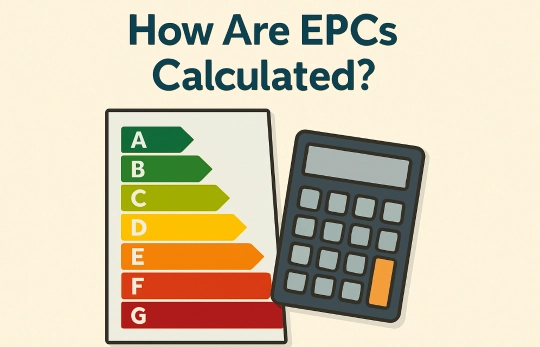An EPC (Energy Performance Certificate) is a legal requirement in the UK when selling, renting, or building a property. It gives a building an energy efficiency rating from A (most efficient) to G (least efficient). But how exactly are EPCs calculated?
Let’s break it down in simple terms—what factors go into an EPC, how assessors work it out, and what you can do to improve your score.
What Is an EPC?
An Energy Performance Certificate:
- Shows how energy-efficient a property is
- Includes a rating from A to G
- Suggests improvements to increase efficiency
- Is valid for 10 years
- Is required by law for most property transactions in the UK
The better the rating, the more energy-efficient (and usually cheaper to run) the property is.
Who Calculates the EPC?
An accredited Domestic Energy Assessor (DEA) carries out an EPC assessment. You can’t do it yourself—it must be done by someone officially trained and registered.
They visit your home and inspect key features that affect energy use.
How Is an EPC Calculated?
EPC ratings are calculated using a government-approved software that follows the Reduced Data Standard Assessment Procedure (RdSAP).
The assessor enters data into the software based on:
1. Property Construction
- Age of the building
- Type of walls (solid, cavity, insulated)
- Roof type and insulation
- Floor insulation
2. Heating Systems
- Main heating type (gas boiler, electric heaters, etc.)
- Efficiency of the boiler or system
- Controls like thermostats and timers
- Secondary heating (e.g. fireplaces)
3. Hot Water System
- How water is heated
- Insulation on the hot water cylinder
4. Windows and Doors
- Double or single glazing
- Draught proofing
- Door types and materials
5. Lighting
- Percentage of energy-efficient lighting (LEDs, CFLs)
6. Renewable Technologies
- Solar panels (PV or thermal)
- Heat pumps
- Wind turbines
The software runs all this information through a formula that estimates:
- Energy usage per square metre
- CO₂ emissions
- Potential cost savings
- Final EPC rating (A to G)
What Does the EPC Rating Mean?
| Rating | Efficiency |
|---|---|
| A | Excellent – very low running costs |
| B | Very good |
| C | Good |
| D | Average (most UK homes fall here) |
| E | Below average |
| F | Poor |
| G | Very poor – high energy costs |
Each certificate also includes a current rating and a potential rating—what your home could achieve with recommended improvements.
Example of EPC Inputs and Effects
- Uninsulated solid walls? Lower rating
- Old gas boiler? Lower rating
- Modern double glazing and loft insulation? Boosts rating
- Solar PV panels? Big rating improvement
Can You Predict Your EPC?
While only a certified assessor can issue an official EPC, you can get a rough idea using online EPC calculators. They ask for basic info about your property and suggest a likely rating range.
How to Improve Your EPC Score
- Add insulation (loft, walls, floor)
- Upgrade to a condensing boiler
- Install double glazing
- Switch to LED lighting
- Use smart heating controls
- Add solar panels
Many of these changes not only improve your EPC but also reduce your energy bills.
FAQs About EPC Calculation
1. How long does an EPC survey take?
Usually between 30–60 minutes, depending on property size.
2. Do I need an EPC for a rented property?
Yes, it’s a legal requirement. As of 2025, landlords will likely need a minimum rating of C (currently E).
3. How accurate are EPC ratings?
They’re based on standard assumptions—not your actual energy usage—so real bills may vary.
4. Can I challenge an EPC rating?
Yes, if you believe it’s incorrect, you can request a re-assessment or raise a dispute with the scheme provider.
5. Where can I check my property’s EPC?
Visit the official EPC register: www.epcregister.com
Conclusion
EPCs are calculated using a mix of building features, heating systems, insulation, and renewable tech. The data is fed into software based on government standards to estimate your property’s energy efficiency.
While the rating is an estimate, it’s a useful guide for buyers, renters, and homeowners to understand how costly a property might be to heat and run. If your rating is low, small upgrades can make a big difference—to your bills and your home’s value.
Also Check:
• How Are Villi Adapted for Exchanging Substances?
• How Are Anchovies Typically Preserved?








